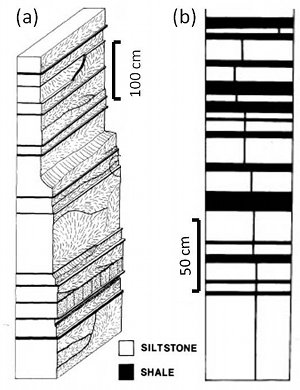| |||||||
|
|
|||||||
|
|
|||||||
| Composite Joints | |||||||
|
A composite joint is a collection of vertically aligned but discrete joint segments, with each segment confined within an individual brittle mechanical layer. Segments in neighboring brittle layers are commonly slightly out of plane with each other; this is called stepping offset. Figure 1 shows a vertical composite joint in profile in a siltstone-shale sequence exposed in a road cut in Watkins Glen State Park, NY (Helgeson and Aydin, 1991). This perspective view is almost parallel to the strike of the joints. The most remarkable feature of the composite geometry (Figure 2) is that the segments appear to be continuous in siltstone layers, while they are discontinuous across shale layers. In spite of the discontinuities along vertical joint traces, however, they are well aligned in a vertical sense. Composite joints occur when a joint propagates incrementally across layered rock with alternating layers of brittle and ductile rocks (from one brittle layer to another). Ductile layers commonly inhibit jointing, though they may allow stress fields to communicate across if the ductile layers are relatively thin. Across thick ductile (inhibiting) layers, joints appear to be independent with a wide range of arbitrary stepping offsets. This phenomenon and a related general trend between the thickness of the shale layers and the degree of the communication among joints across shale, is discussed in the section 'Mechanisms and Mechanics of Composite Joints.' | |||||||
| Reference: |
|||||||
| Helgeson, D., Aydin, A., 1991 |
|||||||
|
Readme | About Us | Acknowledgement | How to Cite | Terms of Use | Ⓒ Rock Fracture Knowledgebase |
|||||||

